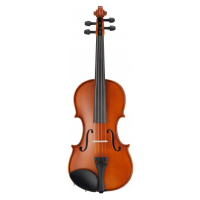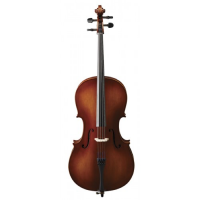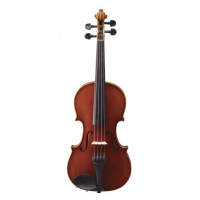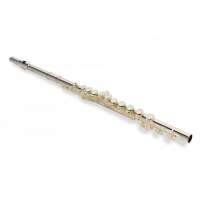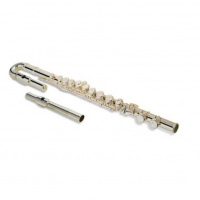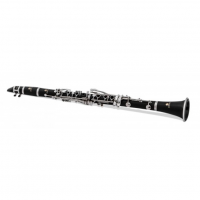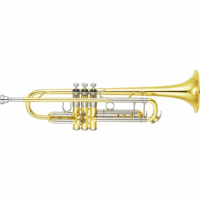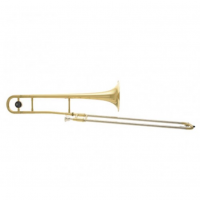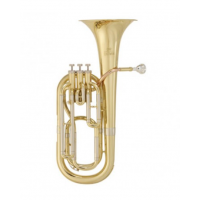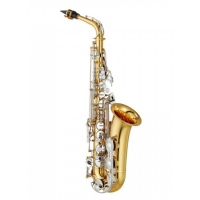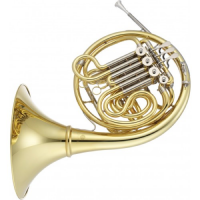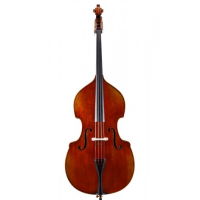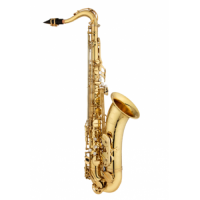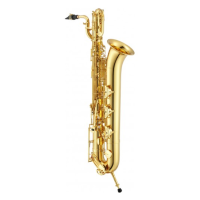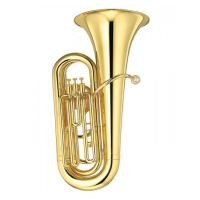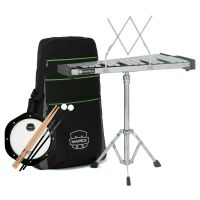Anatomy of the Single French Horn
The name of the single french horn is actually a misnomer: in fact, the horn is a German innovation. With roots in the earliest and humblest of monotone hunting horns, today's single french horn is now an engineering marvel combining eleven feet of interwoven brass tubing and slides.
For many players, a single french horn is a good start to learn the mechanics of producing a good tone and the foundations of proper technique. It is lighter than the double french horn and easier to play. However, as the player becomes more advanced, it is likely that they will need to graduate to a double french horn, which is the standard professional instrument.
If you know how to make a beautiful sound on a single french horn, then you might already know all the parts and pieces of a modern single french horn listed below. Combined into one, the single french horn produces a sound that is like no other instrument in the orchestra.
To be the best you can be at your single french horn playing, you should know all the common names of the parts of the horn and what function they perform. You should also know how individual single french horn parts can be removed and replaced, how horn parts should be serviced and maintained and what to do if you think a part of your single french horn is damaged or broken.
Let's learn about the anatomy of a typical single french horn from end to end. If you'd like to jump ahead, use the anatomy chart above to click a part you'd like to read about first.
WHAT IS THE BELL?
The bell amplifies and scatters the sound waves out to the listeners.
The single french horn's bell is designed to maximize the tone production of the horn by shaping and scattering the sound waves as they emerge at last from the instrument. It gleams with beautifully polished metal: the perfect complement to the french horn's sonorous tone.
Over the centuries the bell has been experimented with rigorously to enhance its contribution to tone, volume and clarity, resulting in the fairly standard shape now seen on most horns. When describing horn size, instrument makers often use the term "flare" instead.
When playing the single french horn, players generally put their hand into the bell. This is a stable way to hold the horn, but it also has an acoustic purpose. Historically, before the french horn had evolved into a completely chromatic instrument, players had to cover the bell with their hands to produce certain tones of the scale. This technique was known as "stopping" and was a clever but extremely difficult technique to perform consistently and well. The invention of valves in the 1800s, which brought a true chromatic scale to the horn, made this practice less necessary.
Part of the tone of the single french horn is due to the materials used to make the bell and other parts. Single french horns made of brass and plated with gold have a more round tone while single french horns made of brass plated with silver tend to sound brighter and sharper in tone.
Remember that the bell scratches and dents with ease if mishandled and removing these blemishes can be expensive or impossible. Never put the single french horn down on the ground, even on a carpet. Store it in its case when not in use.
To remove any fingerprints or dirt smudges from the bell, polish gently with a soft cloth. Touching the bell with bare hands should be avoided. Clean it immediately if you notice any dirt or fingerprints. Oil and moisture from your hands can and will most certainly break down the finish of the single french horn over time if you do not remove it promptly.
Click to return to anatomy chart
WHAT IS THE FINGER HOOK?
The finger hook provides a stable place to grip the horn as the player uses the valves.
The finger hook is a sturdy metal hook found on top of the single french horn just above the valves. It allows the player to hold the instrument steadily in one hand while still using that hand to depress the valves.
Click to return to anatomy chart
WHAT IS THE LEADPIPE?
The leadpipe is the metal tubing that runs from the mouthpiece to the first tuning slide.
The leadpipe is a long metal tube that extends all the way from the mouthpiece to the main tuning slide. It is important to treat your french horn with care when handling it to be sure accidental bumps don't leave dents in the leadpipe. The precise shape of the horn was engineered by acoustic experts, so even a small change to the shape of the french horn's leadpipe can radically change its pure tone.
Click to return to anatomy chart
WHAT IS THE MAIN TUNING SLIDE?
The main tuning slide is used to adjust the overall pitch of the horn.
The main tuning slide, which is the largest slide on the single french horn, is a c-shaped metal tube that can be moved in and out to finely adjust the tuning of the instrument. The further out the slide is pulled, the lower the tone the single french horn will produce.
The tuning slide usually has a small water key on the end for the player to blow excess moisture out of the single french horn.
Click to return to anatomy chart
WHAT IS THE MOUTHPIECE?
The horn's funnel-shaped mouthpiece directs the flow of air and vibration from the player into the horn.
The mouthpiece is a small metal cup that feeds into a small metal tube, with a look that is similar to a funnel. Many mouthpieces are made from brass and come in several standard sizes. However, a player can choose from a variety of mouthpiece sizes and materials to customize the size and feel to their own playing style.
To produce a sound, the player creates a buzzing effect with the lips inside the mouthpiece. The sound waves created by this activity resonate sympathetically with the horn's tubing and valve slides to generate all the notes of the chromatic scale.
The mouthpiece is removable from the horn. It is typically cleaned lightly after every use by running water through it, rubbing lightly with a mouthpiece brush and storing separately from the single french horn in the case.
If your mouthpiece has been accidentally dropped, check it to be sure that it hasn't developed any marks or nicks that can hurt your lips if played. Sharp metal pressed against lips will make a painful combination!
Click to return to anatomy chart
WHAT IS THE MOUTHPIECE RECEIVER?
This metal cylinder holds the mouthpiece while the horn is being played.
The french horn's mouthpiece receiver is a small metal cylinder that is fused to one end of the leadpipe. It has a vital role: connecting the mouthpiece to the horn. The mouthpiece is gently twisted into the leadpipe before playing begins to secure it firmly but not too tightly for playing. It is then taken out for cleaning and storage after playing is finished.
When inserting the mouthpiece into the receiver, place it with light firmness and then give it a small quarter turn while applying light pressure to place it firmly. Be sure not to apply too much pressure! The mouthpiece can easily get stuck and can damage the mouthpiece receiver. However, if your mouthpiece is stuck, all is not lost. Do not try to remove it yourself. Take the horn in to your teacher or instrument shop for repair. There are special tools used to extract mouthpieces that will lift it safely right back out.
Click to return to anatomy chart
WHAT ARE THE ROTARY VALVES?
The rotary valves are used to change the horn's pitch while playing.
Rotary valves contain hard metal cylinders with holes bored through in spots which are exposed when the corresponding valve key is depressed. Depending on the type of single french horn you have, there could be three or four valves. They are known as the first valve, second valve, third valve and fourth valve, with the first being closest to the player when the single french horn is held in playing position.
Different combinations of fingerings and varying amounts of air pressure from the player produce different pitches. The rotary valves direct the stream of air and sound waves into one or more of the valve slides. When the player depresses a key, the holes move and reroute the flow of air in circuits that are larger or smaller depending on the fingering. The longer the route of air, the lower the tone generally will be.
Remember to occasionally lubricate each valve lightly with a few drops of valve oil. This will keep the valves moving properly in their casings and ensure years of service-free performance. Without the oil, you could potentially scratch the inside of the casing and damage the playability of the single french horn.
Click to return to anatomy chart
WHAT ARE THE VALVE KEYS?
The horn's valve keys work the rotary valves to change the pitch of notes during play.
The valve keys are small metal levers that spin a corresponding cylinder inside the rotary valves. This exposes the valve slides to the flow of air and sound waves and ultimately changes the pitch of the instrument with ease.
Click to return to anatomy chart
WHAT ARE THE VALVE SLIDES?
The horn's valve slides work in concert with the pistons to change the pitch of the notes during play.
On the single french horn are found three or four valve slides depending on the model: the first valve slide, second valve slide, third valve slide and fourth valve slide. To change pitch, the player presses down the valve keys in various combinations, which in turn feeds air into one or more of the valve slides. Each is placed at a precise point in the flow of air inside the instrument to produce a specific note in the series.
The player can also make micro-adjustments to the tuning of the single french horn by moving the slides in and out. The slides are fitted tightly so they hold their position by themselves but can still be moved in and out with a small effort. Depending on your model, one or more of the valve slides might have a small ring at the end which makes for easier adjustment.
On a regular basis, the valve slides should be removed and cleaned. Slide grease is the best lubricant to apply. If the valves become stuck, you should never attempt to force them. Take your single french horn to your teacher or a technician for service.
Click to return to anatomy chart
WHAT IS THE WATER KEY?
The water key allows the hornist to expel moisture from the single french horn.
This small metal lever can be pressed to open a small hole in the main tuning slide and allow moisture to escape. It is common for tiny amounts of moisture to collect in the slide and tubing, but this water can be expelled quickly by pressing the water key and blowing sharply into the mouthpiece.
The water key has a tiny felt disc on the end to seal the hole when the water key is closed. Take a look at the disc on occasion to make sure it is clean and still providing a good seal. You don't want dirt or mold to collect anywhere on your single french horn. If the felt disc appears to need replacement, take it to be serviced right away.









